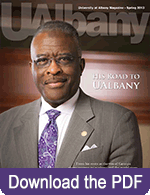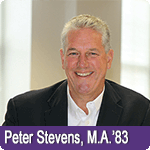Dan Hart, B.S.’83
Reaching for the Stars
By Carol Olechowski
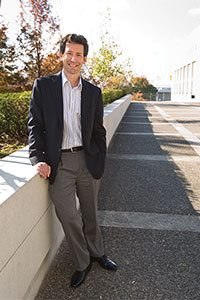
Dan Hart, B.S. '83
Dan Hart believes in reaching for the stars – literally.
“I always wanted to be in the space program,” recounts Hart, Boeing Network & Space Systems’ vice president and deputy program manager for Return to Intercept, Ground-based Midcourse Defense. “In high school, I found the theory of relativity fascinating, and I liked the whole ‘Star Wars’/‘Star Trek’/science-fiction thing happening at the time.”
In 1979, Hart enrolled at the University at Albany; “I knew a lot of kids who were going there, and the school offered a diverse selection of academics.” He found the state capital “appealing. It was a metropolitan area, but not quite New York City, and far enough away” from Valley Stream, N.Y., his hometown, but near enough so that “if I had to get home, I could go on Trailways.”
“Torn” between science and the arts, Hart initially studied both. Freshman year, he landed a lead role in a campus production of the 1920s comedy Boy Meets Girl. (“I played the boy,” he jokes.) “It was an incredible experience. I did theatre in high school, but I had never been in a play where the production values and the set were so professional. We had a guest director from England. A ’20s-style suit was tailored for me. At the same time, Constance Valis-Hill, the movement instructor, spent a lot of time working with me on mime, and I was incredibly grateful. I did some Shakespeare and then focused more on physics.”
Hart conducted research for Distinguished Service Professor James W. Corbett, who would become his mentor. “Dr. Corbett was great. I was amazed that someone who had been all over the world and led an institute would sit and chat with a lowly junior. I told him I wanted to be an astronaut, and he said: ‘Do it. There’s no reason you can’t.’ That was energizing and inspiring.”
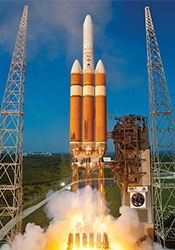
Hart was “one of the primary architects of the Delta IV Launch Vehicle Fleet, which includes the most powerful rocket in operation today.”
With graduation looming, Hart “called NASA, explained I was a senior physics student at Albany and asked how to get into the space program. I wound up talking with somebody at headquarters about payloads on the space shuttle. NASA sent me a book listing companies affiliated with the space program; I checked off about 120 and sent each a letter with my résumé, unaware that the addresses were for company presidents.” The responses included “a couple of encouraging phone calls,” including one from McDonnell-Douglas. Hart interviewed and, “by the beginning of June, I was working at the Kennedy Space Center, at Spacelab, the first big European-American space collaborative and part of the shuttle program. I remember thinking, they don’t really need to pay me for this; I’d gladly do it for nothing!”
Hart worked on Challenger in 1985 and supported Spacelab 2, “one of Challenger’s last successful missions. The Challenger accident was the last shuttle launch I saw from Kennedy.”
Later, at Cape Canaveral, he launched and updated “1960s- and ’70s-vintage rockets,” then relocated to Southern California in 1988 “to get involved in rocket design.” Hart has been engaged in “every aspect of the space program” – including systems engineering for the Delta IV rockets created in the 1990s, missile defense and satellite programs – “and all with the same company, really,” since McDonnell-Douglas, Rockwell, Hughes and other companies “eventually came together with Boeing” through mergers and acquisitions.
Hart never became an astronaut but has no regrets. “I married the love of my life; I had kids. I was enjoying what I was doing. At Boeing, you’re always on a mission, and every mission is important. It doesn’t feel like just a job. It feels like you have a purpose, and that’s great.”
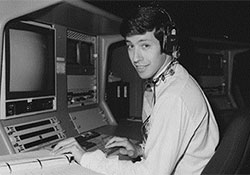
In November 1983, “six months after graduation” from the University at Albany, Dan Hart supported his first launch (Spacelab 1, STS-9) from FiringRoom 1 at Kennedy Space Center.
The critical thinking and communication skills he acquired at Albany continue to serve Hart well. “Boeing operates across the U.S. to England, China, India and Brazil. We have 170,000 people from very different disciplines – structural dynamics, controls theory, structural design, propulsion – working on aircraft and spacecraft. They have to communicate with one another, with company leadership and with the customer so everyone can understand what we’re trying to accomplish and how we’re solving our problems.”
Hart, who travels frequently for work, also does “a little bit of college outreach. Students have a fresh outlook; it plugs you into their energy and vision. I would love to talk to some students at UAlbany.”
In his free time, Hart plays the drums and guitar and reads “a lot of history. I still run, too,” he adds, recalling that the latter pursuit began in college at the urging of boyhood friend and Colonial Quad roommate Randy Holloway, B.A.’83. “And my hobby, raising teenagers, is always exciting!” he laughs, adding that his kids “are both fantastic.”
Talk of his children reminds Hart again of Albany, where he “played intramural soccer and ‘touch’ football most Saturdays, especially if it was snowy or muddy, with buddies Mike Remondino [B.S.’83] and John Beaver [B.A.’83].” At Sutter’s Mill, “a short walking distance” from campus, his diet included “cheeseburgers, fries and a couple of beers for a lot of meals. Probably our favorite bar downtown was the Long Branch. WT’s was great, too.
“I really enjoyed my time at the University. The attention that a couple of key professors gave me was really …” Hart halts mid-sentence. “I get choked up thinking about it.”
- UAlbany Magazine
Spring 2013 - Cover Story
- Features
- Departments
- The Carillon
- Past Issues

